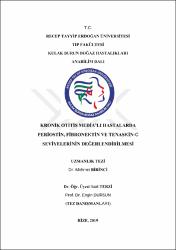| dc.description.abstract | Giriş/Amaç: Kronik otitis media ve kolesteatoma oluşum mekanizmaları yapılan çalışmalara rağmen halen net olarak açıklanamamıştır. Bu çalışmada kronik otitis media'lı hastalarda, hücre adezyonunda, hücre farklılaşması, inflamasyon, fibrozis, anjiogenez ve hücre proliferasyonu gibi birçok mekanizmada görev alan matrisellüler proteinler periostin, fibronektin ve tenaskin-C düzeylerinin değerlendirilmesi amaçlandı. Materyal/Metod: Bu çalışmaya, kliniğimizde kronik otitis media tanısıyla cerrahi uygulanan 65 hasta ile kontrol grubu için 15 gönüllü sağlık personelinden oluşan toplam 80 olgu dâhil edildi. Hastalar kolesteatoma, granülasyon, avivasyon ve kontrol grubu olmak üzere 4 gruba ayrıldılar. Bu olguların tamamının serum periostin, fibronektin ve tenaskin-C düzeyleri biyokimyasal olarak belirlendi. Histopatolojik değerlendirme, uygun doku örnekleri elde edilen 47 hasta ve bunlardan alınan 20 deri örneği üzerinde immünohistokimya yöntemi ile yapıldı. Veriler ki-kare ve anova testleriyle analiz edildi. Sonuçlar: Çalışmayı 22 kolesteatoma, 15 granülasyon, 28 avivasyon ve 15 kontrol grubundan oluşan 80 olgu oluşturmaktadır. Gruplar arasında serum periostin, fibronektin ve tenaskin-C düzeyleri bakımından anlamlı bir fark saptanmadı. İmmünohistokimyasal değerlendirmede, kolesteatoma grubunda fibronektinin stromal boyanması ve periostinin epitelyal boyanması diğer gruplara göre anlamlı olarak yüksek bulundu (p=0,001). Tenaskin-C'nin avivasyon grubunda epitelyal boyanması diğer gruplara göre anlamlı olarak yüksek bulundu (p=0,041). Cilt grubunda ise tenaskin-C'nin stromal boyanması diğer gruplara göre istatistiksel olarak daha az boyandığı tespit edildi (p=0,013). Tartışma: Bu çalışmada birçok önemli hücresel fonksiyonu bilinen periostin ve fibronektin düzeyi kolesteatoma dokusunda hem kronik otitin diğer formlarına, hem de cilt dokusuna göre daha fazla saptanmıştır. Bu da etyolojisi halen net olmayan kolesteatom oluşum mekanizmasında bu moleküllerin görev alabileceğini düşündürmektedir. Ancak bu proteinlerin kolesteatomun etyopatogenezinde rol oynadığını kesin bir şekilde ortaya koymak ve bu moleküllerin kolesteatom tanı ve tedavisinde bir belirteç olarak kullanılabilmesi için daha geniş ve ileri çalışmalara ihtiyaç vardır.
Background / Aim: Despite the studies carried out on mechanisms of chronic otitis media and cholesteatoma formation, it still has not been clarified. The aim of this study was to evaluate the levels of periostin, fibronectin and tenascin-C that are found to be involved in many mechanisms such as cell adhesion, cell differentiation, inflammation, fibrosis, angiogenesis and cell proliferation among the patients with chronic otitis media. Materials / Methods: A total of 80 participants, 65 of whom were the patients having had an operation with the diagnosis of chronic otitis media and 15 of whom were volunteer health personnels for the control group, were included in the current study. The patients were divided into four groups as cholesteatoma, granulation, avivation and control group. Serum levels of periostin, fibronectin and tenascin-C were determined biochemically in all of these cases. Histopathological evaluation was conducted by means of immunohistochemistry on 47 patients with appropriate tissue samples and 20 skin samples collected from those. Data were analyzed with chi-square and anova tests. Results: The study consists of 80 cases consisting of 22 cholesteatoma, 15 granulation, 28 avivation and 15 control groups. There was no significant difference in serum periostin, fibronectin and tenascin-C levels. In the immunohistochemical evaluation, stromal staining of fibronectin and epithelial staining of periostin were significantly higher in the cholesteatoma group than in the other groups (p = 0.001). The epithelial staining of Tenaskin-C in the avivation group was significantly higher than the other groups (p=0,041). On the other hand, in skin group, tenaskin-C stromal staining was statistically less than the other groups (p = 0,013). Discussion: In this study, the levels of periostin and fibronectin, which are known to have many important cellular functions, were higher in cholesteatoma tissue than in other forms of chronic otitis and skin tissue. This suggests that these molecules may be involved in the mechanism of cholesteatoma formation etiology of which is still not clear. However, there is a need for more extensive and advanced studies in order to put forward that these proteins play a role in the etiopathogenesis of cholesteatoma and these molecules can be used as an indicator in the diagnosis and treatment of cholesteatoma. | en_US |


















